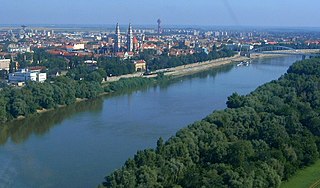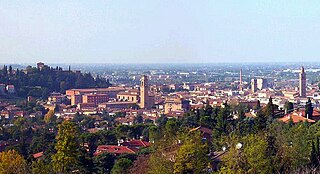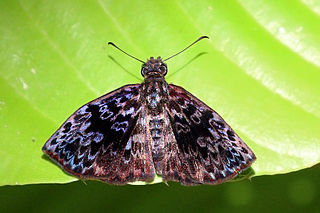| Tisias caesena | |
|---|---|
 | |
 | |
| Scientific classification | |
| Kingdom: | |
| Phylum: | |
| Class: | |
| Order: | |
| Family: | |
| Genus: | |
| Species: | T. caesena |
| Binomial name | |
| Tisias caesena | |
| Synonyms | |
| |
Tisias caesena is a butterfly in the family Hesperiidae. It is found in Brazil.
| Tisias caesena | |
|---|---|
 | |
 | |
| Scientific classification | |
| Kingdom: | |
| Phylum: | |
| Class: | |
| Order: | |
| Family: | |
| Genus: | |
| Species: | T. caesena |
| Binomial name | |
| Tisias caesena | |
| Synonyms | |
| |
Tisias caesena is a butterfly in the family Hesperiidae. It is found in Brazil.

A language family is a group of languages related through descent from a common ancestor, called the proto-language of that family. The term family is a metaphor borrowed from biology, with the tree model used in historical linguistics analogous to a family tree, or to phylogenetic trees of taxa used in evolutionary taxonomy. Linguists thus describe the daughter languages within a language family as being genetically related. The divergence of a proto-language into daughter languages typically occurs through geographical separation, with different regional dialects of the proto-language undergoing different language changes and thus becoming distinct languages over time.

The Tisza, Tysa or Tisa, is one of the major rivers of Central and Eastern Europe. It was once called "the most Hungarian river" because it used to flow entirely within the Kingdom of Hungary. Today, it crosses several national borders.

Isocrates was an ancient Greek rhetorician, one of the ten Attic orators. Among the most influential Greek rhetoricians of his time, Isocrates made many contributions to rhetoric and education through his teaching and written works.

Cesena is a city and comune (municipality) in the Emilia-Romagna region of Italy; and - with Forlì - is the capital of the Province of Forlì-Cesena. Served by Autostrada A14, and located near the Apennine Mountains, about 15 kilometres from the Adriatic Sea. The total population is 97,137.

Romagna is an Italian historical region that approximately corresponds to the south-eastern portion of present-day Emilia-Romagna in northern Italy.

The ten Attic orators were considered the greatest Greek orators and logographers of the classical era. They are included in the "Canon of Ten", which probably originated in Alexandria. A.E. Douglas has argued, however, that it was not until the second century AD that the canon took on the form that is recognised today.
Parataxis is a literary technique, in writing or speaking, that favors short, simple sentences, without conjunctions or with the use of coordinating, but not with subordinating conjunctions. It contrasts with syntaxis and hypotaxis.
Corax was one of the founders of ancient Greek rhetoric. Some scholars contend that both founders are merely legendary personages, others that Corax and Tisias were the same person, described in one fragment as "Tisias, the Crow". And according to Aristotle, Empedocles was the actual founder of rhetoric, but this is also unlikely. It is believed that William Shakespeare derived the name Sycorax from Corax of Syracuse. Corax is said to have lived in Sicily, Magna Graecia, in the 5th century BC, when Thrasybulus, tyrant of Syracuse, was overthrown and a democracy formed.
Thrasymachus was a sophist of ancient Greece best known as a character in Plato's Republic.

The Siceliot people formed a distinct ethno-cultural group in Sicily from about the 8th century BC until their assimilation into the general Sicilian population. As Hellenic colonists and descendants of colonists from Greece, they spoke Greek and participated in the wider cultural and political activities of Greek Sicily and of the Hellenic world as a whole. The Athenian historian Thucydides mentions them in various places in his "History of the Peloponnesian War".
Tisia is a monotypic genus of shield bugs in the tribe Sciocorini, erected by Hoberlandt in 1993. It contains the species Tisia esfandiarii.

The Hesperiini or branded grass skippers are a tribe in the Hesperiinae subfamily of skipper butterflies. They are known as branded grass skippers because all the males in this tribe feature a black diagonal brand of scales on their forewings that exude pheromones to attract females.

The Devil's Dykes, also known as the Csörsz árka or the Limes Sarmatiae, are several lines of Roman fortifications built mostly during the reign of Constantine the Great (306–337), stretching between today's Hungary, Romania and Serbia.

Cycloglypha is a genus of skippers in the family Hesperiidae.

Tisias is a genus of skippers in the family Hesperiidae.

Flatidae are a family of fulgoroid planthoppers. They are cosmopolitan in distribution and are distinguished from others in the superfamily by a combination of characters. Like all other planthoppers, they suck phloem sap of plants. Some species are known to communicate with vibrations through the plant stems. Communication may be with mates, or with ants that tend the nymphs, protecting them and gathering honeydew secretions. Adults of some species have brightly coloured forewings which are tougher and known as tegmina unlike the membranous hindwings which are used for flight. Although a few can be identified by their coloration, most species requires dissection and examination under a microscope with access to literature on already described species.
Aligern or Aligernus was an Ostrogoth military leader, active in the Gothic War (535-554). By the end of the war, Aligern had joined the Byzantine army. The main sources about him are Procopius and Agathias.
The gens Cossutia was a plebeian family of equestrian rank at ancient Rome. It never attained any importance.

Sciocorini is a tribe of stink bugs in the family Pentatomidae.